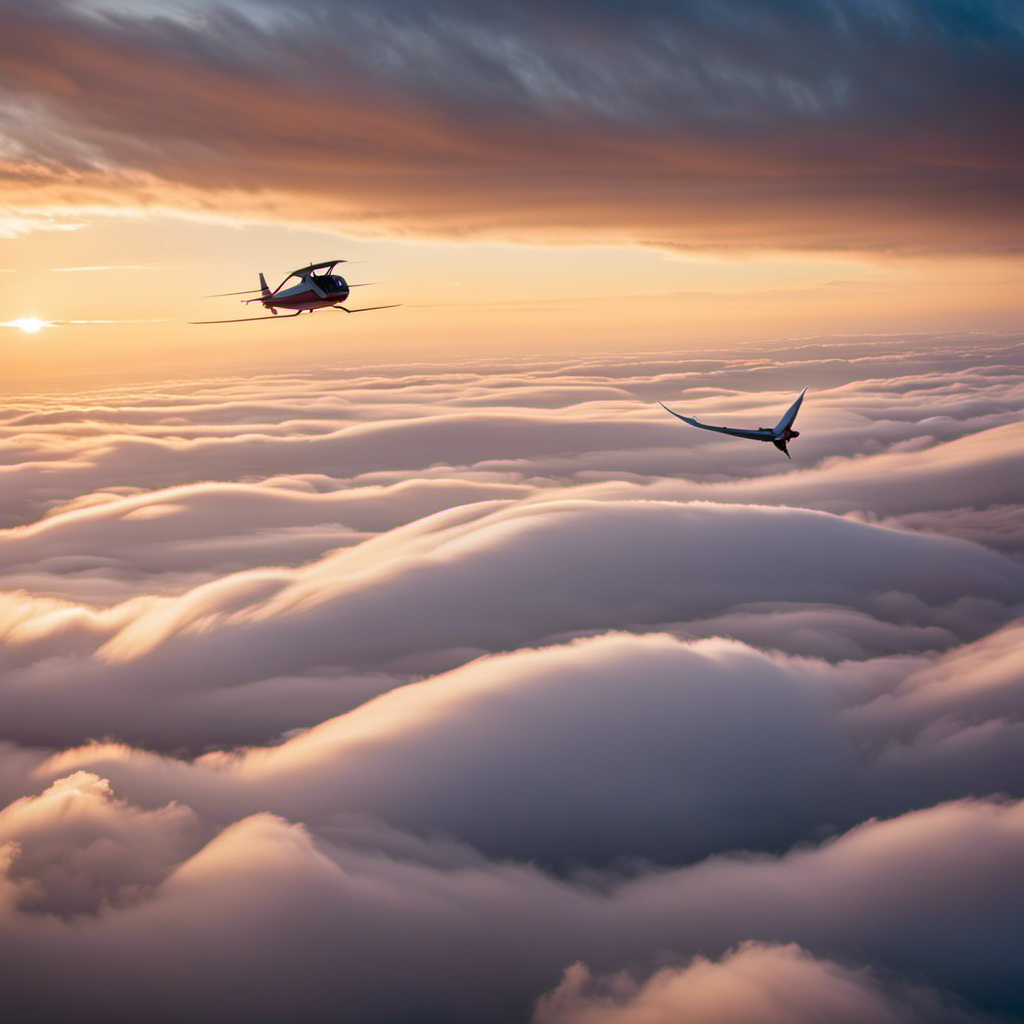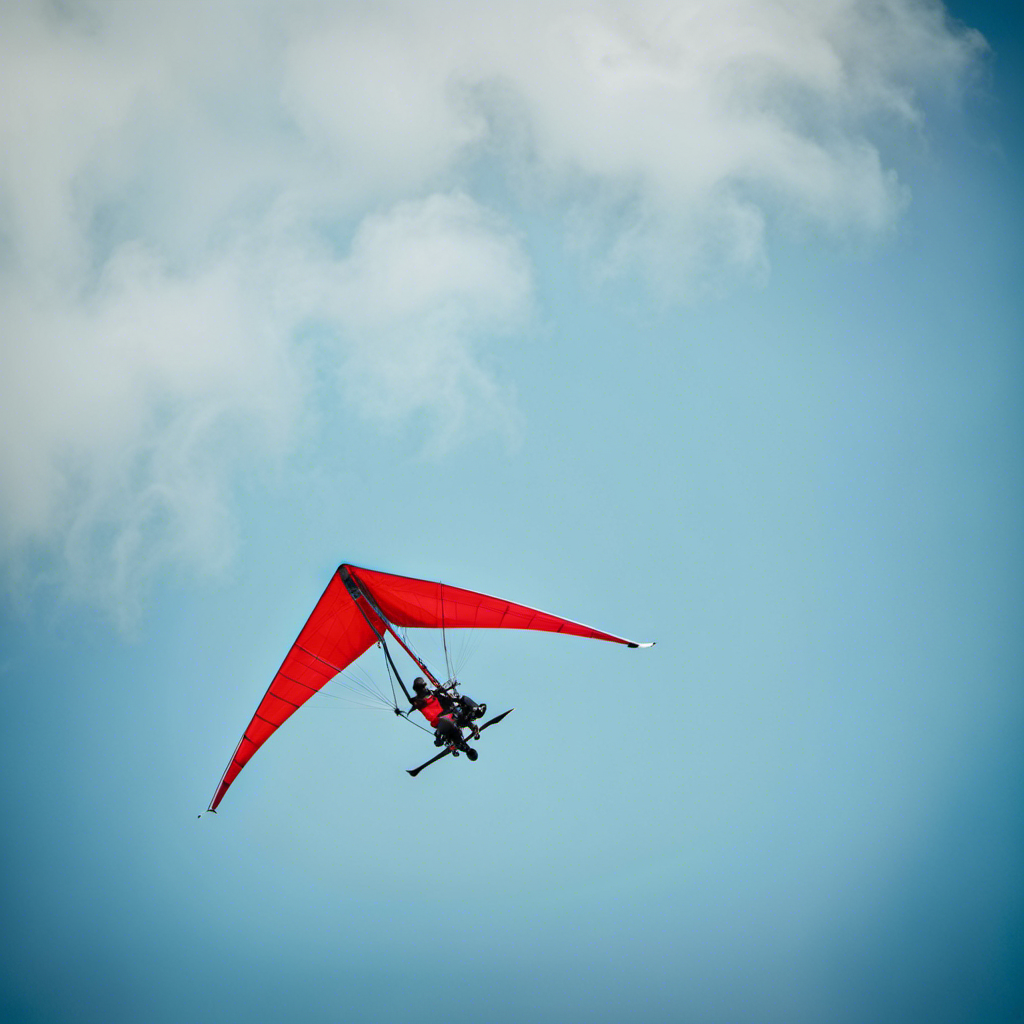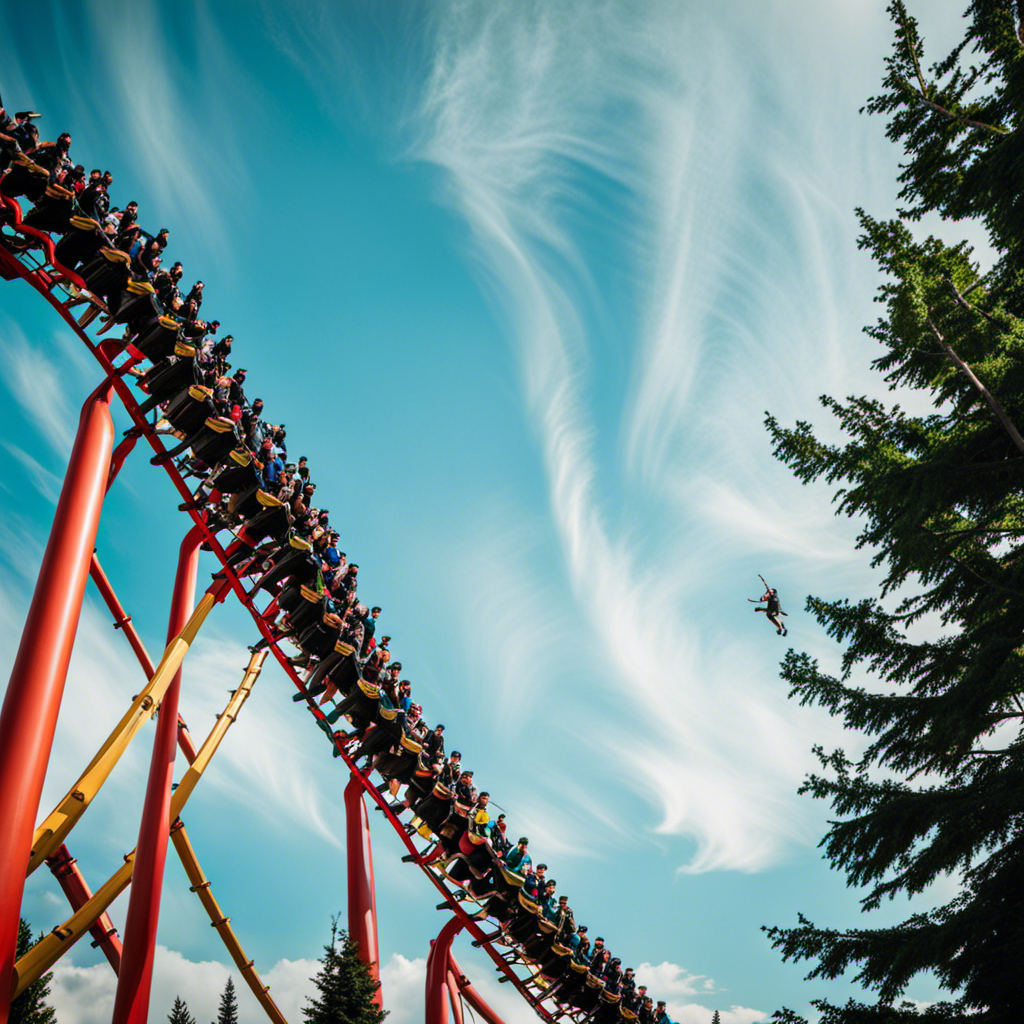I’m here to lead you on an exciting adventure in the thrilling world of microlight flying.
Strap in and prepare to discover the exhilaration of flying in miniature.
In this guide, I’ll share with you the key fundamentals of micro gliding, from finding the perfect location to mastering control of your glider.
We’ll explore different types of micro gliders and delve into the captivating community that surrounds this unique hobby.
So, let’s spread our wings and dive into the incredible world of micro gliding!
Key Takeaways
- Experience the thrill and freedom of flight
- Maintain and care for your micro glider properly
- Join the micro gliding community for support and resources
- Take your skills to the next level with guidance from experienced members
Understanding the Basics of Micro Gliding
Now, let’s dive into the basics of micro gliding so you can get a better understanding of this exhilarating sport.
When it comes to micro gliding, choosing the right equipment is crucial. You’ll need a lightweight glider that is easy to maneuver and control. It’s important to choose a glider that suits your skill level and experience.
Additionally, practicing the right techniques is essential for a safe and enjoyable micro gliding experience. You’ll need to learn how to launch and land the glider properly, as well as how to control your speed and direction. Regular practice sessions will help you develop your skills and build confidence in the air.
Now that you have a grasp of the basics, let’s move on to the next aspect of micro gliding – choosing the right location.
Choosing the Right Location for Micro Gliding
Finding the right spot for micro gliding is crucial when starting out because it can greatly impact your overall experience and safety. Here are four key factors to consider when choosing a location for micro gliding:
-
Suitable Weather: Look for areas with stable weather conditions, minimal wind gusts, and clear skies. This will ensure smooth and enjoyable flights.
-
Researching Local Regulations: Before taking to the skies, make sure to familiarize yourself with the local regulations and restrictions. This includes airspace limitations, flight paths, and any permits or licenses required.
-
Terrain and Landing Areas: Opt for locations with ample space for takeoffs and landings, preferably with open fields or clear flat areas. Avoid areas with obstacles like buildings, trees, or power lines.
-
Safety Considerations: Consider the proximity of emergency services, such as hospitals or fire stations, in case of any unforeseen incidents.
By carefully considering these factors, you’ll be well on your way to choosing the perfect spot for micro gliding.
Now, let’s transition into the next section: learning to control the micro glider.
Learning to Control the Micro Glider
To effectively control the micro glider, you’ll need to develop a strong understanding of the aircraft’s controls and how they respond to your movements. Learning techniques and practicing exercises are essential in honing your skills as a micro glider pilot. Here are some key controls and their corresponding movements:
| Control | Movement |
|---|---|
| Elevator | Controls the pitch (up and down movement) of the glider |
| Ailerons | Controls the roll (side to side movement) of the glider |
| Rudder | Controls the yaw (left and right movement) of the glider |
Building Confidence and Improving Skills
By practicing different maneuvers and familiarizing myself with the controls, I’ve gained confidence and improved my skills as a micro glider pilot.
Building resilience and overcoming fear were crucial in this process. Initially, I was hesitant to take risks and push the limits of the glider. But through perseverance and determination, I gradually built up my resilience, learning to trust both the equipment and myself.
Overcoming fear was a challenge, but with each successful flight, my confidence grew. I learned to embrace the exhilaration and the freedom that micro gliding offers. By conquering my fears, I opened up a whole new world of possibilities.
Now, with a solid foundation of skills and confidence, I am ready to explore different types of micro gliders and expand my horizons even further.
Exploring Different Types of Micro Gliders
You can expand your horizons and try out various types of micro gliders to enhance your flying experience. Exploring mini gliders opens up a whole new world of possibilities and challenges.
Each type of micro glider offers unique characteristics and flying capabilities. From sleek and agile models designed for acrobatic maneuvers to stable and easy-to-fly gliders perfect for beginners, there is a wide range to choose from. By experimenting with different types of micro gliders, you can discover your preferences and develop your skills in various flying techniques.
Whether you enjoy soaring through the sky or performing thrilling aerobatic tricks, there is a mini glider out there that will suit your style.
Now, let’s move on to safety tips and emergency procedures to ensure a safe and enjoyable micro gliding experience.
Safety Tips and Emergency Procedures
When it comes to flying, safety should always be the top priority.
In this discussion, we will delve into some important safety tips and emergency procedures that every pilot should be familiar with.
We will cover the essential pre-flight checklist, which ensures that all necessary preparations are in place before taking off.
Additionally, we will explore how to handle in-flight emergencies and the techniques for landing in challenging conditions, equipping pilots with the knowledge and skills to navigate unexpected situations with confidence.
Pre-flight Checklist
Before takeoff, it’s important to go through a pre-flight checklist to ensure everything is in order. Pre-flight preparations are crucial for a safe and successful micro gliding experience. Here are some important safety measures to include in your pre-flight checklist:
- Inspect the aircraft: Check the overall condition of the aircraft, including the wings, control surfaces, and landing gear.
- Verify fuel and oil levels: Ensure that there is enough fuel and oil for the duration of the flight.
- Test communication devices: Check the functionality of radios and other communication equipment.
Completing these pre-flight checks will help identify any potential issues before takeoff, ensuring a safe and enjoyable flight.
Now, let’s move on to the next section and discuss how to deal with in-flight emergencies without panicking or compromising safety.
Dealing with In-flight Emergencies
During an in-flight emergency, it’s crucial to remain calm and follow the proper procedures to ensure everyone’s safety. Dealing with equipment failure or sudden weather changes can be challenging, but being prepared and knowledgeable can make all the difference.
If you experience equipment failure, such as an engine malfunction or loss of control, it is important to communicate with air traffic control and follow their instructions. Stay focused and try to troubleshoot the issue using any available resources onboard.
When it comes to sudden weather changes, such as turbulent winds or unexpected storms, it’s essential to maintain control of the aircraft and adjust your flight path accordingly. Prepare for potential diversions or alternate routes to avoid hazardous conditions.
Being proactive and vigilant will help you navigate through these emergencies and ensure a safe landing in challenging conditions.
Landing in Challenging Conditions
To successfully land in challenging conditions, you must remain focused and adapt your approach based on the current weather conditions. Challenging weather conditions can make landing a micro glider more difficult, but with the right techniques, you can safely touch down.
Here are three important landing techniques to keep in mind:
-
Maintain a stable approach: In challenging weather conditions, it’s crucial to maintain a stable approach to landing. This means carefully controlling your speed and descent rate, ensuring a smooth and controlled touchdown.
-
Use visual cues: When landing in challenging conditions, visual cues become even more important. Look for landmarks or reference points to help guide your approach and maintain proper alignment with the runway.
-
Be prepared for gusts: Challenging weather conditions often bring gusty winds, which can affect your landing. Stay prepared for sudden changes in wind direction and intensity, and make adjustments accordingly.
By mastering these landing techniques, you can confidently navigate challenging weather conditions and safely land your micro glider.
Understanding the thrill of micro gliding goes beyond just the techniques involved.
Understanding the Thrill of Micro Gliding
Once you’re in the air, you’ll feel the thrill of micro gliding as you soar through the sky. Micro gliding offers a unique and exhilarating experience for thrill seekers.
The benefits of micro gliding are manifold. Firstly, it allows you to experience the freedom of flight in a compact and nimble aircraft. The sheer adrenaline rush you’ll feel as you navigate the air currents and perform daring maneuvers is unmatched.
Additionally, micro gliding provides an excellent opportunity to appreciate the beauty of nature from a different perspective. As you glide through the sky, you’ll witness breathtaking views and serene landscapes that will leave you in awe.
Transitioning into the next section, it is important to note that maintaining and caring for your micro glider is essential to ensure its longevity and optimal performance.
Maintaining and Caring for Your Micro Glider
Take some time each month to inspect your micro glider for any signs of wear or damage. Proper maintenance is essential to ensure the longevity and performance of your glider.
Start by carefully examining the wings, fuselage, and tail for any cracks, dents, or loose parts. Check the control surfaces and hinges for smooth movement and secure attachment.
Store your micro glider in a safe and dry place, away from direct sunlight and extreme temperatures. Avoid storing it in a compressed state, as this can lead to deformation.
When cleaning your glider, use a soft cloth or brush to remove dust and debris. Avoid using harsh chemicals or water, as they can damage the delicate components.
By regularly inspecting and cleaning your micro glider, you can enjoy many hours of safe and enjoyable flying.
Now, let’s explore how you can join the exciting micro gliding community.
Joining the Micro Gliding Community
Joining the micro gliding community is a great way to connect with fellow enthusiasts and share your passion for this exhilarating hobby. When you become part of this community, you gain access to a wealth of knowledge and resources that can enhance your micro gliding experience.
Here are some reasons why joining the micro gliding community is beneficial:
- Safety Precautions and Guidelines:
- You can learn and follow important safety precautions and guidelines to ensure a safe and enjoyable gliding experience.
- Experienced members can provide valuable advice on equipment, weather conditions, and best practices.
- By connecting with others, you can stay updated on any changes in regulations and safety protocols.
Being part of the micro gliding community opens up opportunities for growth and learning. From advanced techniques to new gliding locations, the community can help you take your micro gliding skills to the next level.
Taking Your Micro Gliding Skills to the Next Level
To enhance your skills in the micro gliding community, you can seek out experienced members who can offer valuable tips and guidance. These seasoned gliders have mastered the art of taking risks and executing advanced maneuvers.
When it comes to pushing the limits of your micro gliding abilities, it’s crucial to learn from those who have already paved the way. Engaging with these experts will help you develop the necessary skills and confidence to tackle more challenging flights. They can teach you advanced techniques like steep turns, stall recoveries, and precision landings.
Additionally, they can provide insights on risk assessment and management, ensuring your safety while pushing the boundaries. So, don’t hesitate to connect with experienced members of the micro gliding community and take your skills to the next level.
Frequently Asked Questions
Can I use a regular glider for micro gliding?
No, it is not recommended to use a regular glider for micro gliding. Micro gliders are specifically designed for this activity and have safety precautions in place to ensure a safe and enjoyable experience.
Are there any age restrictions for participating in micro gliding?
There are typically age restrictions for micro gliding due to safety concerns. It is important to check with the specific micro gliding organization or instructor for their age requirements. Additionally, weather conditions play a crucial role in determining if it is safe to participate.
How much does a micro glider typically cost?
Micro gliders typically cost between $5,000 and $15,000, depending on the model and features. When considering the cost, it’s important to weigh the pros and cons, such as the thrill of flying versus the ongoing expenses of maintenance and fuel.
Can I micro glide in any weather conditions?
Indoor micro gliding is possible in any weather condition as it takes place in controlled environments. However, safety precautions during micro gliding, such as proper training, supervision, and equipment, should always be followed to ensure a safe experience.
Are there any specific fitness requirements for micro gliding?
Fitness benefits of micro gliding include improved cardiovascular health, increased muscle strength, and enhanced flexibility. Safety precautions such as wearing a helmet and proper training are essential. Remember, always consult a professional before starting any new fitness activity.
Conclusion
In conclusion, micro gliding is an exhilarating sport that offers endless possibilities for adventure and exploration. By understanding the basics, choosing the right location, and learning to control your micro glider, you can build confidence and improve your skills.
Exploring different types of micro gliders adds excitement and variety to your flying experience. Maintaining and caring for your micro glider ensures its longevity and optimal performance.
Joining the micro gliding community allows you to connect with like-minded enthusiasts and share your passion. So, take your micro gliding skills to the next level and soar to new heights!
With a heart that soars as high as the skies, Aria, affectionately known as “Skylark,” is the driving force behind Soaring Skyways. Her journey into the gliding world began as a young dreamer gazing up at the soaring birds, yearning to experience the weightlessness and freedom they embodied. With years of experience both in the cockpit and behind the scenes, Aria’s commitment to the gliding community is unwavering.










